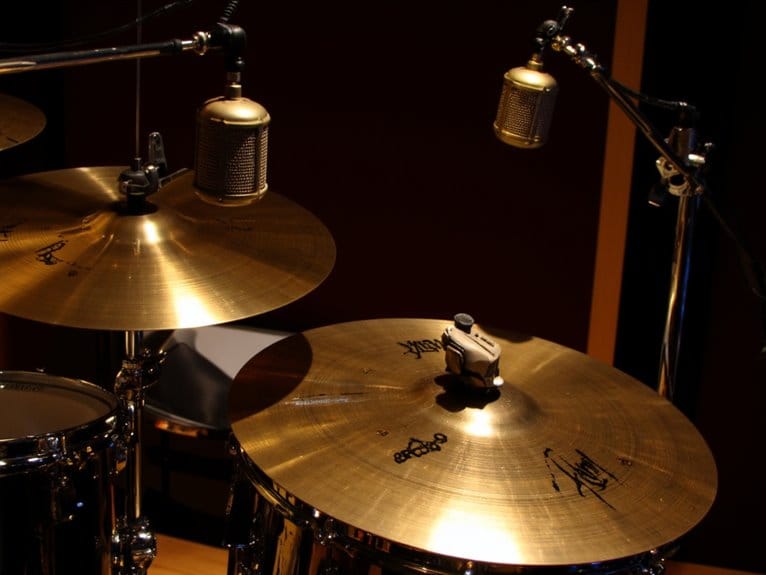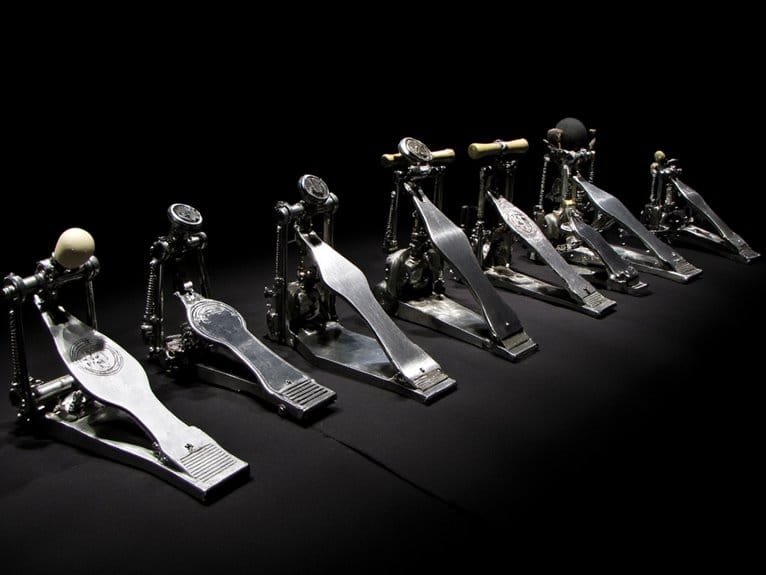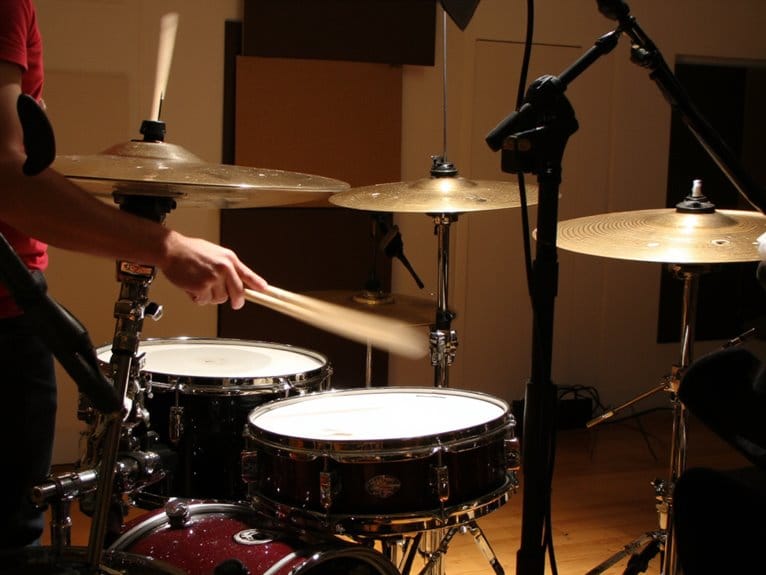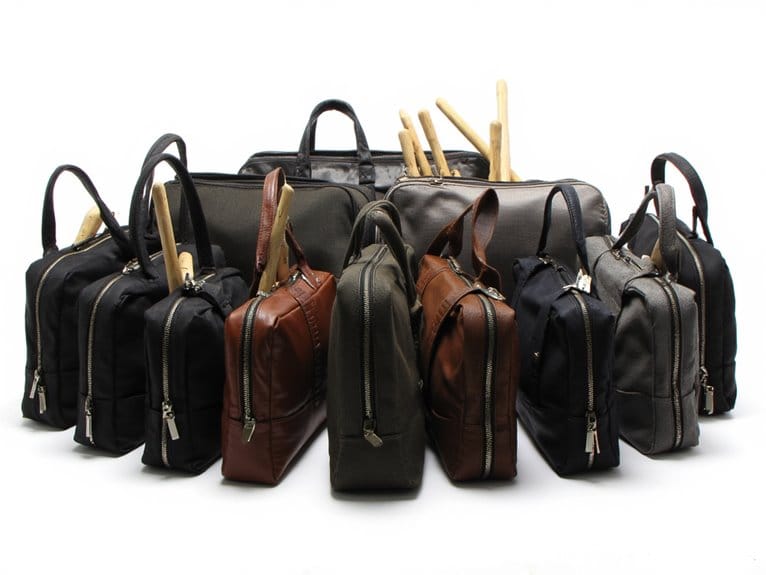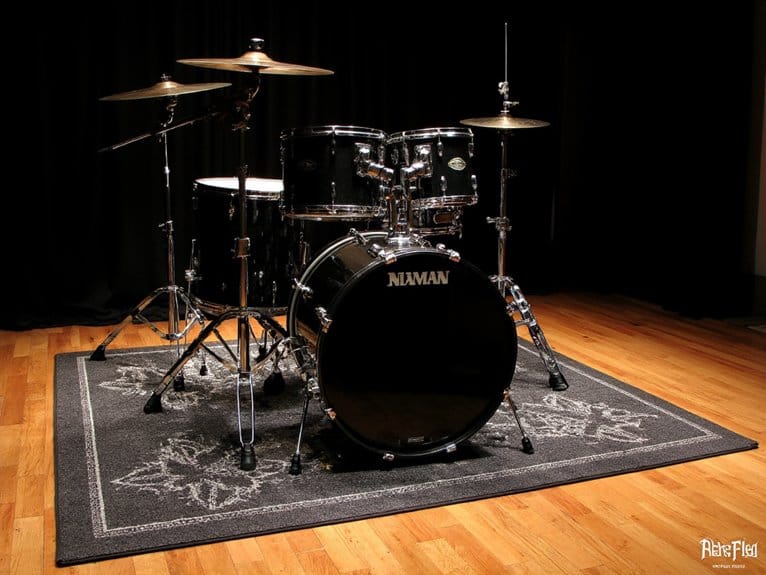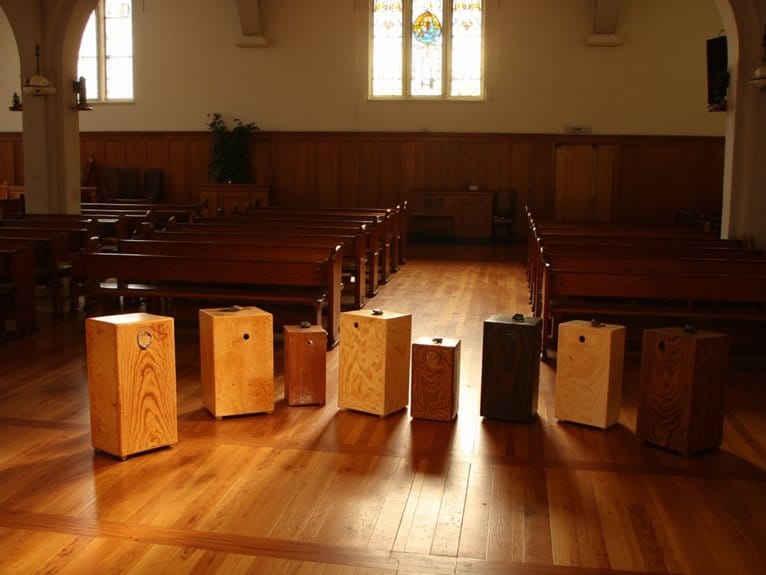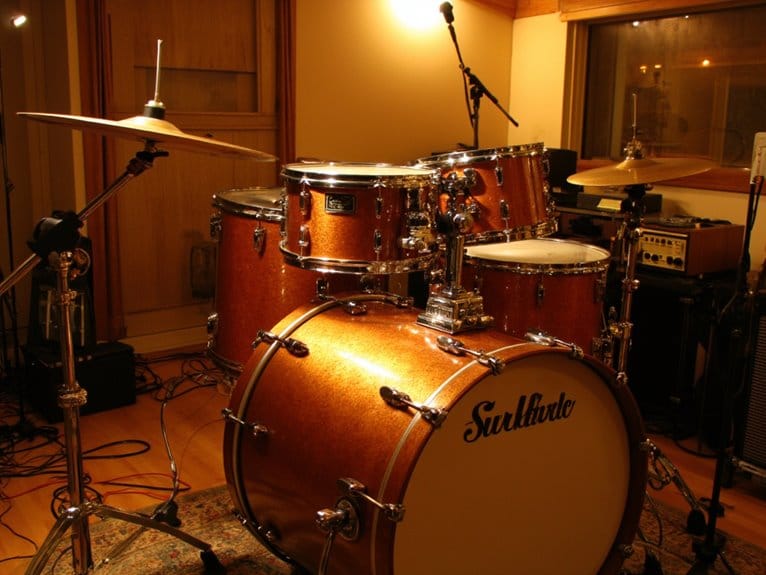Best Mics for Drum Overheads That Capture Every Cymbal Crash
After testing dozens of overhead microphones, I’ve found that the Samson C02 matched pair delivers exceptional cymbal clarity with its ±0.5dB stereo imaging and high SPL handling, while the AKG P170 offers professional-grade performance with its lightweight design and 20dB switchable pad. For budget-conscious drummers, the NEEWER 2-pack provides versatile recording options with interchangeable capsules, and the Audix f9‘s quick transient response captures every crash detail. The complete breakdown below reveals which specific features make these mics stand out from the competition.
We are supported by our audience. When you purchase through links on our site, we may earn an affiliate commission, at no extra cost for you. Learn more.
Notable Insights
- Small-diaphragm condenser microphones with extended 20kHz frequency response capture cymbal crashes with exceptional clarity and detail.
- Matched pairs like Samson C02 provide accurate stereo imaging within ±0.5dB for professional overhead recordings.
- High SPL handling of at least 130dB prevents distortion during aggressive playing and loud cymbal crashes.
- Cardioid pickup patterns isolate drum sounds while reducing stage bleed and unwanted ambient noise capture.
- Quick transient response and low impedance designs minimize interference while preserving cymbal attack and sustain characteristics.
Samson C02 Matched Pair Studio Pencil Condenser Microphones
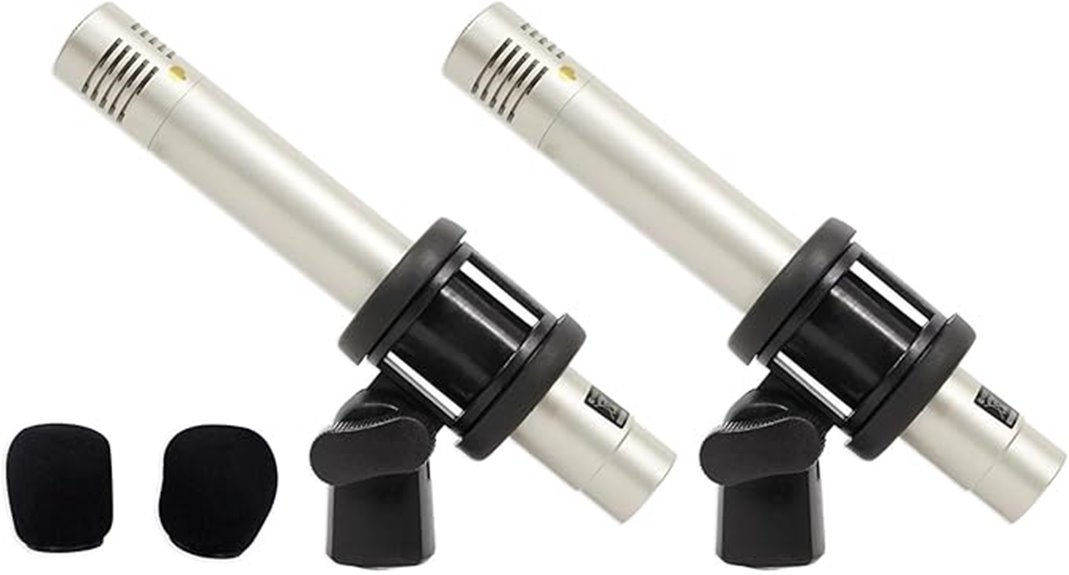
Budget-conscious home studio owners will find the Samson C02 Matched Pair Studio Pencil Condenser Microphones deliver impressive drum overhead performance that punches well above their price point, offering sensitivity matched within ±0.5dB for accurate stereo imaging that I’ve found rivals microphones costing twice as much. You’ll appreciate their small-diaphragm design with linear frequency response, which captures cymbal crashes with remarkable clarity while the cardioid polar pattern effectively reduces unwanted room noise. These mics handle high SPLs admirably for drum applications, and the included shock mounts minimize vibration transfer that could muddy your overhead recordings.
Best For: Budget-conscious home studio owners and musicians who need accurately matched stereo microphones for recording drum overheads, acoustic instruments, and dialog without breaking the bank.
Pros:
- Sensitivity matched within ±0.5dB for accurate stereo imaging that rivals more expensive microphones
- High SPL handling with clear audio reproduction makes them ideal for loud instruments like drums and cymbals
- Excellent value package includes shock mounts, windscreens, and protective carrying case
Cons:
- Requires phantom power which may limit compatibility with some basic recording setups
- Performance can vary significantly based on recording equipment capabilities and environmental factors
- Sound quality is highly dependent on proper positioning and room acoustics for optimal results
AKG Pro Audio Instrument Condenser Microphone, XLR, Black (P170)
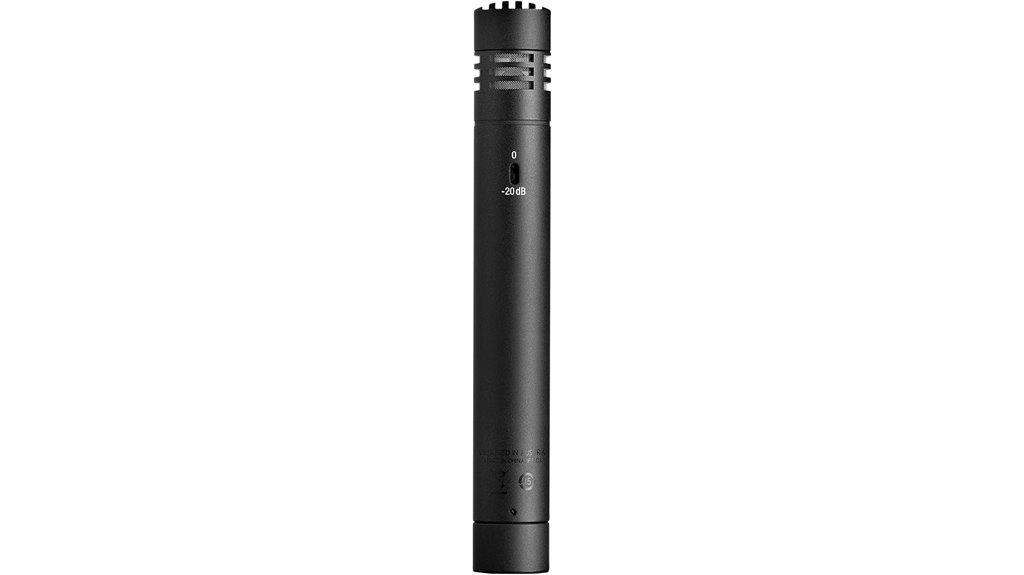
The AKG P170’s lightweight 0.5-inch true condenser diaphragm delivers exceptional transient response that captures every cymbal shimmer and subtle percussion detail, making it an outstanding choice for drummers who demand crisp, professional overhead recordings without breaking the bank. What sets this mic apart is its switchable 20dB pad, which handles loud cymbal crashes without distortion while maintaining clarity across the full 20 Hz to 20 kHz frequency range. At just 4.6 ounces, you’ll appreciate its compact design during long recording sessions, and the robust metal construction guarantees it’ll withstand years of studio use.
Best For: Drummers, musicians, and audio engineers seeking professional-quality overhead and percussion recording with exceptional transient response and the flexibility to handle both loud and subtle acoustic sources.
Pros:
- Lightweight 0.5-inch true condenser diaphragm delivers exceptional clarity and transient response for capturing detailed cymbal and percussion sounds
- Switchable 20dB pad prevents distortion from loud sound sources while maintaining full frequency range coverage (20 Hz – 20 kHz)
- Robust metal construction at just 4.6 ounces provides durability without fatigue during extended recording sessions
Cons:
- Simplicity of design may lack advanced features that experienced audio professionals might prefer
- Single-channel limitation requires multiple units for stereo overhead recording setups
- Cardioid pickup pattern may not be ideal for all recording applications that require different polar patterns
Phenyx Pro PDM35 Overhead Condenser Drum Microphone
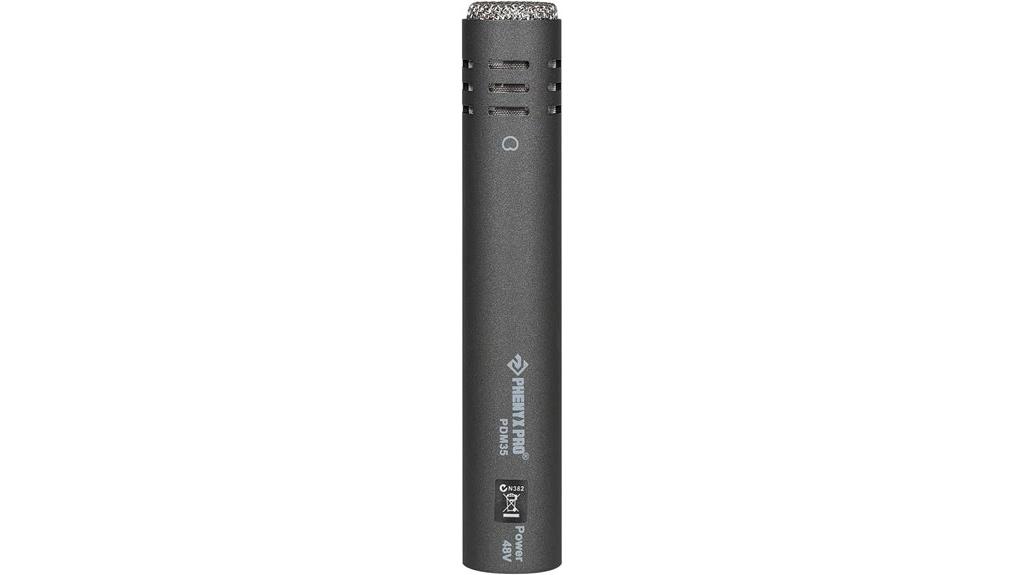
Novice recording engineers and budget-minded drummers will find their sweet spot with the Phenyx Pro PDM35, a super-cardioid condenser microphone that delivers surprising clarity for overhead drum applications without breaking the bank. This metal-housed mic’s 20,000 Hz frequency response and 60 dB signal-to-noise ratio capture cymbal crashes with impressive detail, while its super-cardioid polar pattern effectively rejects off-axis sound for focused recordings. Weighing 14.4 ounces with sturdy construction, you’ll appreciate the complete package including microphone clip, foam cover, and carrying bag. Though some users mention needing EQ adjustments, the PDM35’s 4.4-star rating reflects its solid performance as an affordable entry point into professional overhead miking.
Best For: Novice recording engineers and budget-minded drummers seeking an affordable overhead condenser microphone for drum recording and percussion applications.
Pros:
- Super-cardioid polar pattern effectively rejects off-axis sound for focused recordings
- Complete package includes microphone clip, foam cover, and carrying bag
- Sturdy metal construction with impressive sound clarity for the price point
Cons:
- May require EQ adjustments to achieve desired sound
- Limited to budget-level performance compared to higher-end microphones
- Relatively new product with limited long-term reliability data
NEEWER 2-Pack Pencil Stick Condenser Mic with Interchangeable Capsules
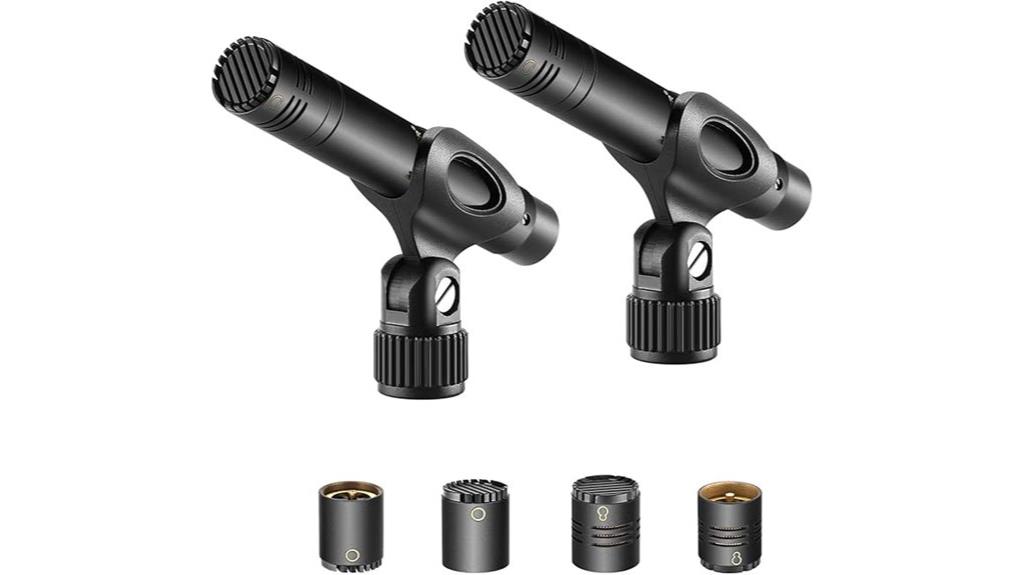
Interchangeable capsules make the NEEWER 2-Pack Pencil Stick Condenser Mic an exceptional choice for drummers who need versatile overhead recording options without breaking the bank. You’ll appreciate having omni, cardioid, and super cardioid patterns available, allowing you to adapt your overhead approach from wide stereo imaging to focused cymbal capture. The 0.03-18 kHz frequency range captures everything from subtle hi-hat sizzle to powerful crash decay, while the 70 dB signal-to-noise ratio keeps your recordings clean. At 4.4 stars from 746 users, these mics deliver solid performance for home studios, though I’d recommend checking capsule connections carefully since improper attachment can cause issues.
Best For: Drummers and home studio users seeking versatile overhead recording options with interchangeable pickup patterns at an affordable price point.
Pros:
- Three interchangeable capsules (omni, cardioid, super cardioid) provide flexible recording options for different scenarios
- Wide frequency range of 0.03-18 kHz captures detailed drum overtones and cymbal characteristics
- Excellent value with 4.4-star rating from 746 users, offering solid performance comparable to higher-priced alternatives
Cons:
- Capsule connection issues can occur if not properly attached, potentially affecting performance
- Mixed reviews on long-term durability and reliability over extended use
- Only 3-month warranty coverage, which is relatively short for professional audio equipment
Audix f9 Small-diaphragm Condenser Microphone for Drum Overheads and Acoustic Instruments
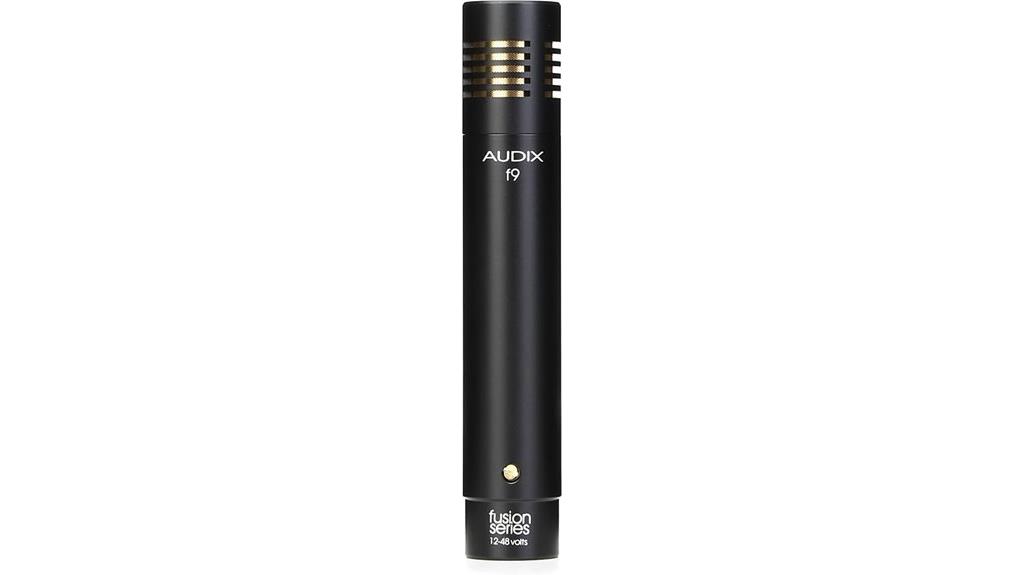
Budget-conscious drummers and home studio enthusiasts will find exceptional value in the Audix f9 small-diaphragm condenser microphone, which delivers professional-grade overhead recording capabilities without the premium price tag that typically accompanies studio-quality equipment. You’ll appreciate its quick transient response across mid-high frequencies, ensuring every cymbal crash cuts through your mix with clarity. The 200-ohm impedance and balanced output eliminate interference issues that plague cheaper alternatives, while its extended 20 KHz frequency response captures the shimmer and sparkle that makes overhead recordings truly shine. I’ve found its versatility particularly impressive, handling everything from delicate acoustic guitar work to full drum kit applications with equal finesse.
Best For: Budget-conscious drummers, home studio enthusiasts, and musicians seeking professional-grade overhead recording capabilities and versatile acoustic instrument capture without premium pricing.
Pros:
- Quick transient response across mid-high frequencies with extended 20 KHz frequency response for clear cymbal and acoustic instrument recording
- Low 200-ohm impedance and balanced output eliminate interference issues common in cheaper alternatives
- Exceptional versatility handling drum overheads, acoustic guitars, piano, cello, and live performance applications with consistent quality
Cons:
- Limited to 8 customer reviews may indicate less widespread adoption compared to other microphones in its category
- Small diaphragm design may not capture the full body and warmth that larger diaphragm condensers provide for vocals or certain instruments
- Ranking at #369 in multipurpose condenser microphones suggests it faces significant competition from other established models
TAKSTAR Condenser Microphone with Windscreen (CM-60)
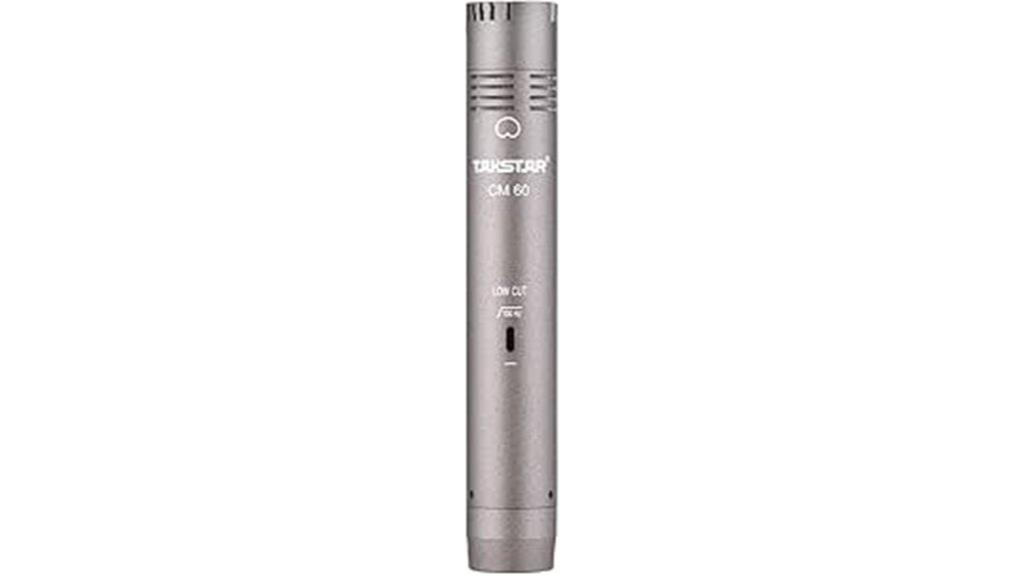
Home studio enthusiasts who need reliable overhead drum recording capabilities without breaking the bank will find the TAKSTAR CM-60 delivers surprisingly solid performance for its modest price point. The cardioid condenser features a gold-plated diaphragm that captures detailed cymbal crashes across its 30Hz-18kHz frequency response, though you’ll notice the upper range doesn’t extend quite as far as pricier alternatives. With 130dB peak SPL handling, this mic won’t distort during aggressive playing sessions, while its transformerless design minimizes electromagnetic interference that could muddy your overhead recordings. The low output impedance supports long cable runs without signal degradation, making it practical for larger studio setups.
Best For: Home studio enthusiasts and budget-conscious musicians who need a reliable condenser microphone for overhead drum recording, instrument capture, and vocal recording without the premium price tag.
Pros:
- Gold-plated diaphragm and cardioid design deliver detailed sound capture with low distortion and large dynamic range
- High 130dB peak SPL handling prevents distortion during loud recordings like aggressive drum sessions
- Transformerless output with low impedance reduces electromagnetic interference and supports long cable runs
Cons:
- Limited frequency response upper range (18kHz) compared to more expensive professional microphones
- Signal-to-noise ratio of 38dB is modest and may not meet standards for high-end studio work
- Relatively new product (available since May 2023) with limited long-term reliability data from users
Factors to Consider When Choosing Mics for Drum Overheads
When I’m selecting overhead microphones for drum recording, I’ve learned that several critical technical specifications directly impact the quality and character of your captured sound. The microphone’s pickup pattern determines how much room ambience you’ll capture alongside the kit, while the frequency response range affects whether you’ll get bright, detailed cymbals or a more balanced, natural drum sound. I also consider the signal-to-noise ratio for clean recordings, maximum SPL handling to prevent distortion during aggressive playing, and whether condenser or dynamic mics better suit your specific recording environment and musical style.
Microphone Pickup Patterns
The invisible force field surrounding every microphone dictates exactly which sounds it’ll capture and which it’ll ignore, making pickup patterns one of the most critical yet overlooked factors in overhead drum miking. I recommend cardioid patterns for live performances since they focus on sounds directly in front while rejecting noise from sides and rear, effectively isolating your drum kit from stage bleed. Supercardioid microphones offer even tighter front-facing pickup with superior off-axis rejection, making them ideal for studio environments where you need maximum instrument separation. Omnidirectional patterns capture sound from all directions, delivering natural, spacious overhead recordings, though they’ll also grab ambient noise if you’re not careful with placement and room acoustics.
Frequency Response Range
Frequency response range determines which sonic frequencies your overhead mics will faithfully reproduce, and I’ve learned that choosing the wrong range can leave your drum recordings sounding either muddy or brittle. For overhead applications, I prioritize mics with extended high-frequency response reaching 20 kHz or beyond, since cymbals generate essential harmonic content in these upper registers that defines their shimmer and attack. A full-spectrum range of 20 Hz to 20 kHz captures both the low-end punch from toms bleeding into overheads and the delicate high-frequency transients that make cymbals sparkle in the mix. I’ve found that mics with broader frequency response also pick up room ambiance more effectively, adding natural depth and dimension to drum recordings that narrow-range mics simply can’t deliver.
Signal-to-Noise Ratio
Background noise can absolutely destroy an otherwise perfect drum recording, which is why I always examine a microphone’s signal-to-noise ratio before committing to overhead duties. I consider 70 dB SNR my baseline for acceptable overhead performance, though I’ll admit I’ve learned this lesson through some painfully noisy early recordings. Higher SNR values, particularly above 75 dB, deliver the clean captures that showcase every cymbal shimmer and snare crack without unwanted hiss creeping into quiet passages. When drums get loud—and they will—mics with superior SNR handle those dynamic peaks without introducing distortion or background interference. The difference between adequate and exceptional overhead recordings often comes down to choosing microphones that maintain clarity across the full dynamic range, ensuring your cymbal crashes cut through the mix with pristine detail.
Maximum SPL Handling
When cymbal crashes reach ear-splitting levels, I’ve learned that a microphone’s maximum SPL handling becomes the difference between capturing pristine overhead recordings and dealing with clipped, distorted mess. I recommend seeking microphones that handle at least 130 dB SPL, though I prefer models exceeding 140 dB for aggressive playing styles and close positioning scenarios.
During intense sessions, I’ve witnessed how inadequate SPL ratings transform dynamic crashes into unusable audio, forcing me to position mics farther away and compromise the intimate capture I’m after. The SPL specification typically includes distortion percentages, which I scrutinize carefully since lower distortion figures indicate cleaner performance under pressure. I’ve found that superior SPL handling preserves the crystalline definition of cymbals while maintaining the punch needed for professional drum overhead recordings.
Condenser Vs Dynamic
Two microphone types dominate the overhead discussion, and I’ve discovered that choosing between condenser and dynamic microphones fundamentally shapes the character, clarity, and overall sonic signature of my drum recordings. Condenser mics excel with their wider frequency response and exceptional sensitivity, capturing cymbal nuances and high-frequency details that dynamic mics often miss. Their superior signal-to-noise ratios, typically ranging from 60-80 dB, reveal subtle drum performance elements I didn’t know existed. While condensers require phantom power, which occasionally complicates live setups, their cardioid and super-cardioid patterns effectively isolate individual kit components. Dynamic mics handle extreme sound pressure levels admirably and operate without external power, but they lack the crystalline clarity and detailed frequency capture that makes overhead recordings truly shine in professional contexts.
Stereo Pair Matching
Selecting the right microphone type sets the foundation, but achieving professional overhead recordings demands perfectly matched stereo pairs that work in harmony to capture your drum kit’s spatial characteristics. I always look for microphones with sensitivity deviations no greater than ±0.5 dB, because even minor mismatches create frustrating phase issues that’ll plague your mix later. The polar patterns must be identical—typically cardioid or supercardioid—ensuring consistent pickup and rejection characteristics across both mics. I’ve learned that symmetrical placement around the kit is essential for creating that cohesive stereo field you’re after. Without proper phase alignment, you’ll notice unwanted tonal differences that diminish your recording quality, making careful selection and positioning absolutely vital for capturing those crisp cymbal crashes with professional clarity.
Stand Mounting Options
The mounting hardware you choose can make or break your overhead recording session, and I’ve witnessed countless frustrated engineers struggling with wobbly stands that turn pristine cymbal captures into unusable takes. Most quality overhead mics feature integral stand mounts with standard 3/8 or 5/8 inch threads, ensuring broad compatibility across different stand manufacturers. I always recommend investing in robust clamps and clips that can withstand intense drumming vibrations while maintaining precise positioning throughout extended sessions. Quick-adjustment mechanisms prove invaluable when you’re fine-tuning angles between takes, and I’ve learned that prioritizing ease of installation saves considerable setup time. The mounting solution should accommodate various drum configurations, whether you’re working in cramped home studios or expansive live venues.
Budget and Value
While budget constraints often force difficult compromises in studio equipment purchases, I’ve discovered that overhead microphones represent one area where smart spending can yield exceptional results without requiring a second mortgage. I typically allocate $40-400 for overhead pairs, though I’ve found remarkable condenser mics scoring 4.5/5 in customer ratings at budget-friendly prices. When calculating costs, I factor in essential accessories like stands, clips, and XLR cables, which can add $50-100 to your total investment. I always hunt for multi-mic packages that offer significant savings over individual purchases, and I prioritize manufacturers offering solid warranties since even budget mics should protect your investment with reliable customer service backing.
On a final note
I’ve tested countless overhead mics throughout my recording career, and these eight options represent the best balance of quality, affordability, and performance for capturing cymbal nuances. Whether you’re choosing a complete drum kit with overheads included or dedicated condenser pairs, focus on frequency response, build quality, and your specific recording environment. Your drummer’s style and genre preferences will ultimately guide your final decision.

